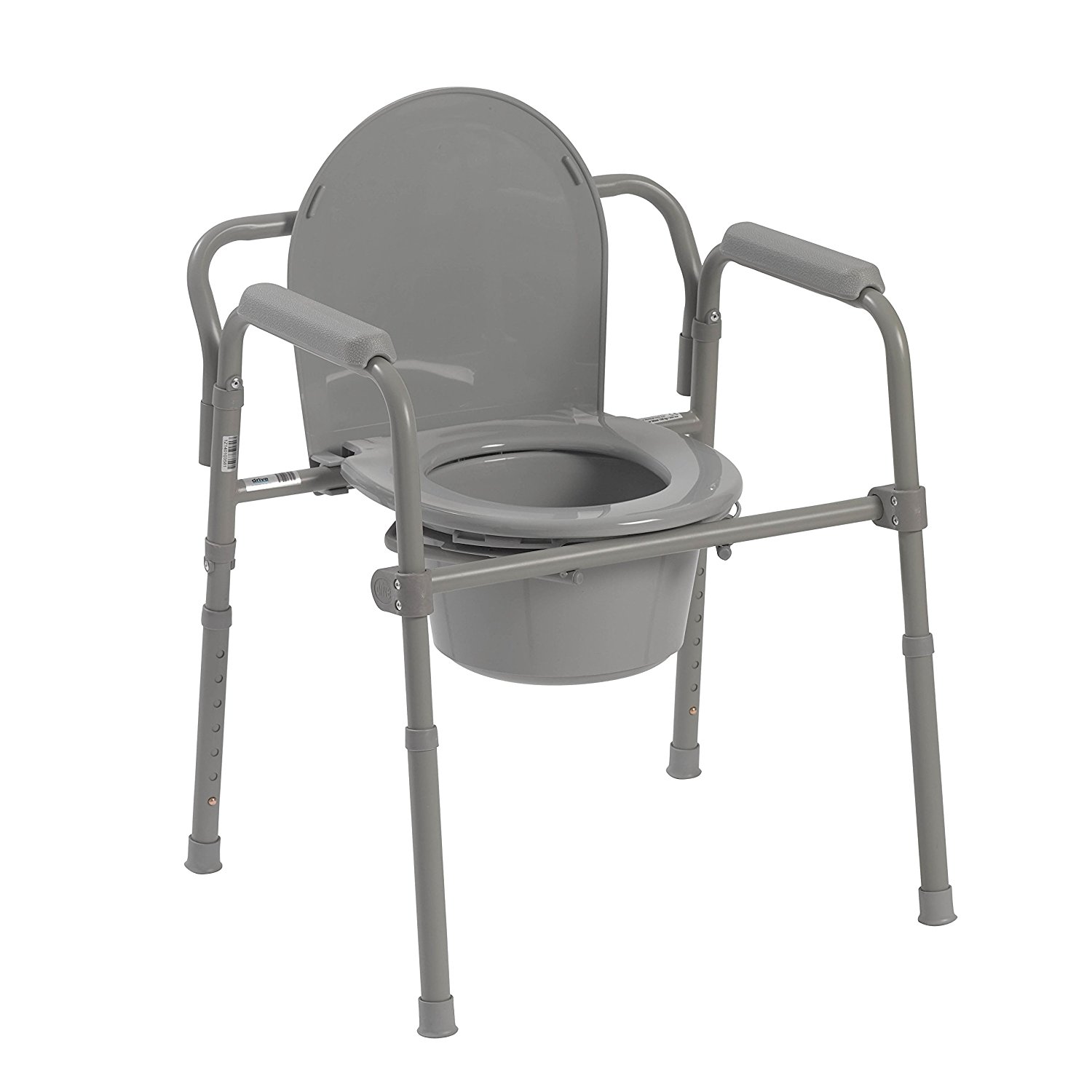7 Tools for Hip & Knee Replacement

After a hip or knee replacement, pain may hinder the recovery process.
Movement Is one of the best ways to recover, however, there are a few tools that may help assist ease the process of performing daily living activities.
These are not the only items that can be used, however, they are basic enough that most people do use these tools at home to help recover faster for hip and knee replacement.
1. 3 IN 1 COMMODE
This is the number 1 equipment used for almost all types of disabilities. It can be used for patients that have has strokes, muscle weakness, hip/knee replacement and many more physical dysfunctions. It is called a 3 in 1 commode as it can be used for distinct functions. It can be used as a bedside commode as it has a bucket that can be added to the bottom of the seat in case walking distance to the restroom isn’t an option. It can be used over the toilet without the bucket, where the height can be adjusted to raise the height of the seat to prevent over-bending of the knees after surgery. It can also be used as a shower chair if the shower is wide enough to fit this equipment. It does have handles on either side to help push off and slowly lower self. It can also stabilize a person if core muscles are weak to prevent falling with the side armrests. It is a very useful tool to help with any disability.

- Easily opens and folds flat for storage and transportation.
- Durable plastic snap-on seat and lid installs without pushing buttons.
- Grey powder coated steel welded construction increases strength and durability.
- Comes complete with 7.5 qt commode bucket with carry handle, cover and splash shield.
- Weight Capacity: 350 lbs.
2. TUB TRANSFER BENCH/SHOWER CHAIR
One of the many questions that are asked, “How am I going to shower?” Hygiene is important even after surgery and many cannot tolerate standing for extended periods of time due to pain. Sitting to take a shower to conserve energy and reduce pain is a more efficient way to bath than to not shower. There are several types that can be used in the shower/tub. If a patient has a tub, then a tub transfer bench would be more appropriate to use, if the patient has a walk-in shower, than a shower chair would be recommended.

- DURABLE & SECURE.
- COMFORTABLE: WIDE SEAT WITH SMALL DRAINAGE HOLES.
- VERSATILE & EASY TO USE.
- LIGHTWEIGHT & PORTABLE.
- SIT, SHOWER & RELAX.

- DURABLE & SECURE.
- COMFORTABLE: WIDE SEAT WITH SMALL DRAINAGE HOLES.
- VERSATILE & EASY TO USE.
- LIGHTWEIGHT & PORTABLE.
- SIT, SHOWER & RELAX.
3. REACHER
Many people on hip precautions forget to practice their hip restriction movements, placing themselves back in the hospital dislocating their hip after surgery. Making sure to keep their major hip precautions of NO BENDING, NO TWISTING, and NO CROSSING LEGS is sometimes difficult to remember. Using a Reacher, which is a long-handled stick with ton like tips, can help with grabbing or picking up items off the floor or at a distance to maintain the hip precautions of NO BENDING. Patients forget the bending to reach for socks and shoes is included in the no bending precaution. A Reacher is highly beneficial and can be used even if the patient does not have a hip/knee replacement. Reaching for items located in an upper cabinet can be difficult, a Reacher can be helpful. I, being short, have found a Reacher to be useful in my own life.

- Pick-up items from the top shelf, floor, lawn or behind furniture.
- Save your back and avoid a stepping stool.
- Can pick up items as large as 5 lb.
- Padded, anti-slip handle and contoured trigger matches the natural shape of your hand for comfortable, pain-free use..
- Jaw can rotate a full 360 degrees in 90 increments to be used both vertically and horizontally.
4. SOCK AID
Many people usually never hear of this equipment until they struggle with putting their own socks on. This could be due to limited ROM, hip/knee precautions, muscle weakness or back pain. Patients can also use this tool if they’ve had back surgery and have certain restrictions on movement. There is two type of sock aids, a soft and flexible type, or a hard and stable type. For those that have muscle weakness and struggle with the range of motion, a stable hard sock aid would be more beneficial to them. For those that have the strength, a soft sock aid can be used. Both do the same function and help maintain the hip/knee precautions of not bending forward or crossing the leg over the other to place socks. A tip that can help the foot slide into the sock aid is to place baby powder on the sock aid before placing foot. This helps with sliding the socks on if feet are moist.

- MOLDED PLASTIC FRAME! Durable long lasting frame for everyday use.
- Deluxe foam handles for comfort and gripping ease for those with low dexterity.
- Adds additional 33″ to your reach, minimal bending required for donning socks/hoisery.

- Hand washable.
- Perfect for people with limited mobility due to arthritis, hip, knee or back injuries.
- The two 29″ long loop handles on this deluxe stocking and sock aid reduce the need to bend.
- Flexible plastic core has a unique three finger design that holds stockings easily with nylon interior to reduce friction.
- Terrycloth exterior prevents sock from slipping.
5. SHOE HORN
This equipment is used to assist in putting on shoes with ease. Many patients struggle with wearing shoes when the back of the shoe folds inwards as the foot is placed into the shoe. The shoe horn is placed inside the shoe before placing the foot into the shoe. The shoe horn is slightly bent, to allow the patient’s heel to easily slide into the shoe without any difficulties of the shoe folding inwards. This helps with keeping the hip/knee precautions of no bending or crossing legs over to wear shoe. This equipment can also be used with different physical dysfunctions such as patients with stroke or muscle weakness.

- Thicker and heavier than other metal shoe horns.
- Perfect Angle for Sliding Feet Into Shoes and Won’t Damage or Cut into Your Shoe.
- Long length of this shoehorn allows you to put on your shoes without bending over or crouching.
- Perfect for Men, Women, Seniors, Pregnancy, Elderly, Kids, more back pain disability special needs tall people.
- Easy Grip Handle-Durable lanyard protect your hands avoid hurt.and easily hanging.
6. GAIT BELT
A gait belt is generally used to wear around the waist for a therapist or aid to assist the patient with transfers. It is also used to hold the patient for safety precautions to stabilize the patient. A gait belt can be used differently when it comes to hip/knee surgery. Many patients struggle with lifting the affected side onto and out of the bed. Using the gait belt as a different function, it can be used when tied, into a leg lifter to allow the patient to be more independent with transfers in and out of bed. This is a cheap and inexpensive way to be more independent with transfers of the leg as well as maintaining any precautions.

- Secure by Personal Safety Corporation 60 inch by 2 inch gait belt designed to aid in walking or transferring fall risk patients.
- Adjustable up to 60″ length and features loop to hold excess belt length.
- High tensile metal buckle provides a secure closure.
- 100% Cotton webbing construction is durable and comfortable for the patient.
- Machine washable and dryable at high temperature setting.
- Weight capacity: 300 lbs.
7. WALKER
Many doctors refer patients to use a walker at the beginning stages of surgery to prevent any falls or loss of balance. There any many types of walkers but a standard rolling walker would be functional enough for hip/knee replacement surgery. Walkers can be used for many different difficulties including patients with strokes, balance difficulties, muscle weakness, traumatic brain injury and many more. It is a temporary device to help until balance, strength and regain of the range of motion of the knee and hip is recovered.

- Comes with wheels and a vinyl contoured hand grip.
- Each side operates independently to allow easy movement through narrow spaces and greater stability while standing.
- Easy push-button mechanisms may be operated by fingers, palms or side of hand.
- Newly designed rear glide cap allows for walker to slide easily and smoothly over most surfaces.
- Sturdy 1 inch diameter aluminum construction ensures maximum strength while remaining lightweight.
Keep Moving!
Movement is the key to a successful Hip & Knee recovery. These equipment tools can help aid the process of recovery and functional independence. A few more items that can be combined or grouped together to be sold as a package is known as the hip kit. It includes a Reacher, sock aid, a dressing stick, shoe horn and a long-handled sponge. It would be cheaper to purchase the hit kit than to buy them individually. A dressing stick can be used to assist with dressing, however, a Reacher can do the similar function. The long handle sponge would be beneficial to reach areas such as the lower body extremities and back when bathing. These are a few items that can help patients be independent at home without the assistance of others. Energy conservation and decreasing pain in one of the main benefits of using these OT tools to improve function.

- Comes with wheels and a vinyl contoured hand grip.
- Each side operates independently to allow easy movement through narrow spaces and greater stability while standing.
- Easy push-button mechanisms may be operated by fingers, palms or side of hand.
- Newly designed rear glide cap allows for walker to slide easily and smoothly over most surfaces.
- Sturdy 1 inch diameter aluminum construction ensures maximum strength while remaining lightweight.
